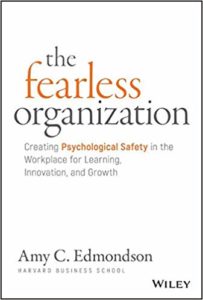 By: Amy Edmondson
By: Amy Edmondson
Reviewed by: Leah Parkhill-Reilly
The Premise: Amy Edmondson is a Harvard researcher and professor who is best-known for coining the phrase “psychological safety” and delivering a phenomenal TED talk on the subject. At the heart of it, being a great leader (and ultimately a great boss) is about how effectively you can create trust within a team. For Edmondson, psychological safety is the creation of trust at a group or organizational level. Psychological safety doesn’t mean we’re all best friends and buy birthday cakes (although that would be lovely). Psychological safety describes a climate where people feel safe enough to take interpersonal risks by speaking up and sharing concerns, questions or ideas. It is a work environment where individuals can be candid and ask questions.
The book is framed in three sections, the first being an overview of psychological safety, the second the impact of a safe workplace and the third section is focused on tools to build a fearless organization. Edmondson really underscores the impact of psychological safety in a Volatile, Uncertain, Complex and Ambiguous (VUCA) world. The more complex and uncertain that environment, the more important it is for a leader to provide safety so that employees can be candid. A manager who creates psychological safety and trust does so by inviting feedback and being deeply curious. Teams without that safety net, for example in a high command and control environment, may inadvertently create an environment with poor choices and questionable behaviour just to achieve results.
The Bottom-line: I wanted to love this book more than I actually did. I’m such a strong advocate of psychological safety however the writing style is unfortunately academic and “business-y” which at times makes for a very dense read. The saving grace being the summary bullets at the end of each chapter reminding the reader of the key takeaways from each section. If you’ve watched the TED talk or read any of Edmondson’s articles then the first and second sections feel a bit repetitive however the third section has great pragmatic tools for leaders to use within their teams and organizations.
The lessons that really landed for me were the notion that psychological safety is not a “perk”; it’s essential for producing high performance in a VUCA world. I also loved that Edmondson highlighted the importance of a leader being willing to be vulnerable and say “I don’t know”; her research found this plays a powerful role in engaging hearts and minds of others. The major win really is chapter 7 as there are a bunch of useful tools and in particular a Leadership Self-Assessment for how well one is doing at creating psychological safety.
Recommendation: Recommended for leaders who want to learn more about psychological safety from an academic and practical perspective to incorporate into their leadership toolkit. Recommend jumping to Chapter 7 if you’re already familiar with Edmondson’s work.




